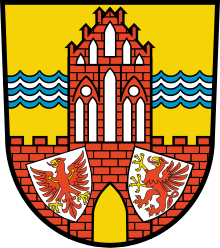Landin Treaty
The Landin treaty from 1250 is considered to be the hour of birth of the Uckermark , a historically evolved landscape in Brandenburg . It was a strategic part of the expansive German state expansion to the east and north under the jointly ruling Ascanian margraves Johann I and Otto III. The place of the conclusion of the contract and namesake was the place Landin (later divided into Hohen- and Netherlandsin), a district of today's municipality Mark Landin in the district of Uckermark , where the Brandenburgers probably set up camp on the Kappenberg between Hohen- and Netherlandsin.
history

The Ascanians' contractual partner was the Pomeranian Duke Barnim I ("the city founder") from the Pomoran family of the Griffins , who ceded the northern Uckermark ( Terra uckra ) to the Welse , Randow and Löcknitz against half of the Wolgast region to the Ascanians. Thus the entire former areas of the Ukranen and Retschanen , united to the Uckermark, belonged to the Mark Brandenburg . Only a year earlier, Johann I and Otto III. the mark expanded with its victory in the six-year Teltow War by the last parts of the Barnim and Teltow .
Wolgast had fallen to the Ascanians through their marriage policy : John's first wife Sophia, the daughter of King Waldemar II of Denmark , had brought the land into the marriage as a dowry in 1230 . On behalf of his sons ( Johanneische Linie ), Johann I raised a claim to the Wolgast inheritance in the negotiation with Barnim I, but then waived in favor of the settlement.
At first glance, the barter was not very lucrative for Barnim I. Since it was clear that the Ascanians would enforce their interests by force after unsuccessful negotiations and the Pomeranians were militarily inferior, Barnim I was forced to sign a treaty for better or worse. However, he was able to negotiate that the Ascanians for the death of Wartislaw III. withdraw agreed contingent succession; Barnim I was the cousin of Wartislaw. This agreement, according to which Wartislaw's territory should fall to Brandenburg without direct heirs in the event of his death , was imposed by the two Askanians on Wartislaw in the Treaty of Kremmen on June 20, 1236. In addition, Wolgast's transmission kept the Ascanians away from the Baltic Sea .
Text excerpts
The western border is not mentioned in the text of the contract, as the Uckermark met the Ascanian land of Stargard here. The text says about Duke Barnim I, among other things,
“That he would have captured and retained the Wolgast Castle and Land, which would have passed to the sons of his lord, the Margrave Johann, under inheritance law, and as a result would have lost the grace of his two lords, the Margraves. With his friends and loyal followers before the face, he had to regain their favor, concluded the settlement, the Uckerland with tithes and all accessories from the river Welse to through the middle of the Randowbruch, from there to the middle of the river Löcknitz, from the Löcknitz to the Ucker, from this river straight through to the river Sarow to be given voluntarily, with the reservation of the rights of the Bishop of Cammin. [...] he owns all his goods as a fief of the margraves. The castle and country Wolgast and also all his goods with his cousin Wartislaw received in full hands and vowed the margrave to everyone, where he could follow with honor, to perform vassal services. "
literature
- Heidelore Böcker : Barnim I. In: Eberhard wood, Wolfgang Huschner (ed.): German princes of the Middle Ages . Edition Leipzig, Leipzig 1995, pp. 292-304.
- Dietmar Lucht: Duke Wartislaw III. from Pomerania . In: Baltic Studies , New Series, Vol. 53, 1967, pp. 13–15.
- Dietmar Lucht: The city policy of Duke Barnim I of Pomerania 1220–1278 (= Publications of the Historical Commission for Pomerania, Series V: Research on Pomeranian History, Vol. 10). Cologne / Graz 1965.
- Uwe Michas: The conquest and settlement of northeast Brandenburg. In the series: Discoveries along the Märkische Eiszeitstraße , Volume 7. Society for Research and Promotion of the Märkische Eiszeitstraße, Eberswalde 2003, pp. 39–41, ISSN 0340-3718 .